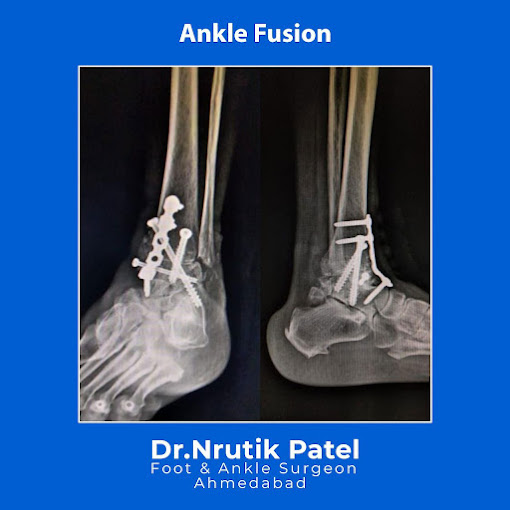
Ankle arthritis can cause significant disability and affect daily living
Arthritis in the ankle can lead to pain, swelling, deformity, and instability in the ankle joint. Ankle arthritis affects the tibiotalar joint, which forms between the shin bone (tibia) and ankle bone (talus).
The incidence of ankle arthritis is five to 10 times less than arthritis of larger joints like the hip and knee.
Types of Ankle Arthritis :-
common types of Ankle arthritis
Osteoarthritis
Osteoarthritis (OA) is a degenerative joint disease where the cartilage that cushions the ends of a joint wears away gradually. Osteoarthritis often occurs because of typical wear and tear on a joint that happens with age. But many cases of ankle osteoarthritis are related to a previous ankle injury. Injury can damage the cartilage directly or change how the ankle joint works, leading to cartilage deterioration over time.
Post-traumatic arthritis
This type of arthritis develops in the foot as a result of injury, even one that happened a long time ago. For example, a sprain, fracture, or dislocation in the ankle may damage cartilage. That can lead to premature deteriorating of the joint. Symptoms may appear within a few years, or it can take decades for joint damage from an injury to cause pain.
Rheumatoid arthritis
Rheumatoid arthritis (RA) is a chronic inflammatory disease, in which the body’s immune system attacks itself. The joints of the ankles can be affected by RA. Difficulty with ramps, inclines, and stairs are the early sign of rheumatoid arthritis. Standing and basic walking can become painful as the RA in the ankle advances.
Other types of inflammatory arthritis such as psoriatic arthritis and peripheral spondyloarthritis can also affect the ankle joint.
Diagnosis :
Blood tests- CBC,ESR,CRP,RA,URIC ACID, ACCP
X-ray-Both leg standing view to see the arthritic changes and alignment also
CT Scan- CT scan is useful tool to see the quantity of arthritic changes of ankle joint.
MRI- MRI is useful to see the soft tissue involvement and for bone marrow changes.
Management :
The goal with these treatments is to help patients function and do their daily activities with less pain.
Medication for Arthritis in the Ankle
Medications are an important part of treatment for arthritis in the ankle. They can help slow bone loss, relieve inflammation, and ease pain. Here are the types of medications used commonly in arthritis treatment.
Nonsteroidal anti-inflammatory drugs
NSAIDs can help relieve pain and swelling in the joints.
Lifestyle Modification
Lifestyle modifications are a big part of helping treat arthritis in the ankle.



